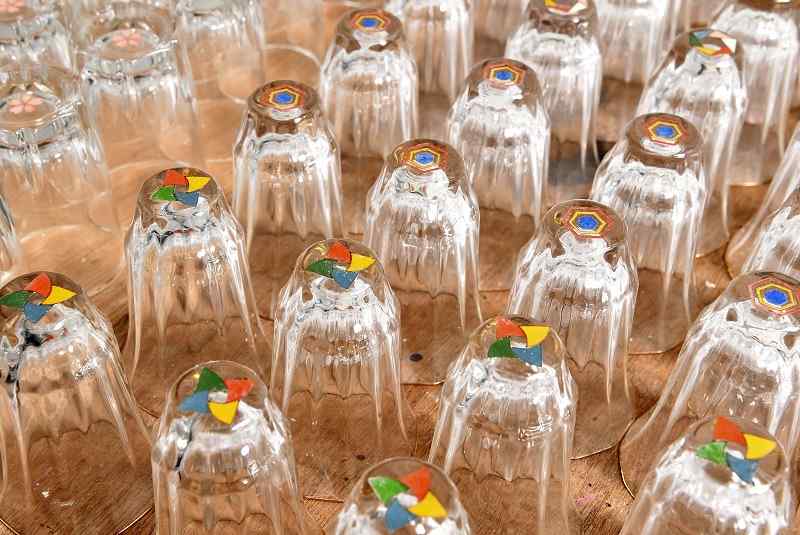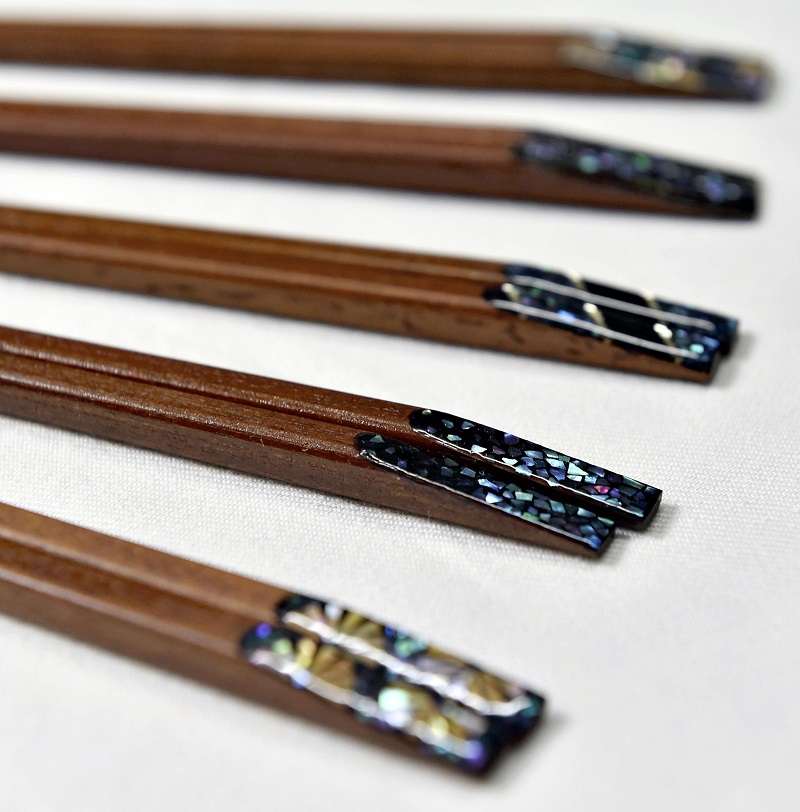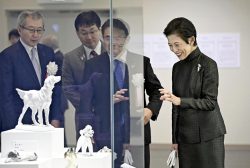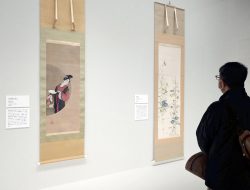
Raden work applied to glasses in Takaoka, Toyama Prefecture
16:51 JST, November 17, 2022
Small thin pieces of abalone shells were being carefully attached to the bottom of a dodecagonal glass with a pointed stick.
The work requires careful attention from Takeshi Musashigawa, 41, the fourth-generation owner of Musashigawa Kobo factory for raden shell-inlay work in Takaoka, Toyama Prefecture. When a glass finished with lacquer or other techniques is filled with sake or water, patterns like those of a kaleidoscope appear on the surface due to the reflection of the raden work.

Takeshi Musashigawa performs raden work
Takaoka lacquerware dates back to the early Edo period (1603-1867) when it began as an industry promotion measure led by Maeda Toshinaga, the second-generation head of the Kaga Maeda family. The lacquerware production has a traditional division-of-labor structure that divides work into three stages of kiji (wood base), kashoku (decoration) and nuri lacquer application. In 1975, the lacquerware was designated by the government as a traditional craft product. Sales exceeded ¥2 billion in the 1980s and it is said that wholesalers lined up at lacquerware factories. However, sales slumped in the mid-1990s. According to the Takaoka municipal government, sales dropped to about ¥230 million in 2020. The number of craftsmen has declined, and the shortage of successors is now a serious issue.
Aogai-nuri is a raden technique for Takaoka lacquerware and was used to decorate wooden vessels and furniture. However, a newly developed coating material has made it possible to use the technique for glass and other materials.

Raden work on chopsticks
“We are trying to apply the raden work to resin, metal and other materials so that we will be able to survive if kiji-ya [wood crafters] cease to exist,” Takeshi said. He said he has been working with a sense of urgency since he joined the factory in 2004. Takeshi and his wife Hiromi, 42, who is also a raden craftsperson, have produced products for modern lifestyles such as smartphone cases and chopsticks that can be washed in dishwashers, so that young people will use them.
Recently, they have been using social media to promote their products, resulting in more orders from customers in distant places. The couple made a skateboard decorated with skull and flame patterns using the raden technique with an eye to showcase their work overseas, and it received the Japan Urushi Association chairperson award at this year’s national lacquerware exhibition.
Their next goal is to apply raden to jewelry for daily use. They are trying to flexibly incorporate the traditional technique into modern lifestyles.
"Culture" POPULAR ARTICLE
-

Van Cleef & Arpels Dazzles with Art Deco Artisanry at Tokyo Exhibit
-

Disney’s ‘Twisted-Wonderland’ Animated Series Puts Villains in Spotlight: New Show Features School Inspired by Classic Disney Films
-

Japan Plans to Distribute Manga Overseas Via New Platform
-

Ayumi Hamasaki’s Shanghai Concert Canceled Day Before Schedule as Part of Beijing Backlash
-

‘The World Masterpiece Theater Series’ Celebrates 50 Years; Animator Looks Back on Creating Anime Classics
JN ACCESS RANKING
-

Tokyo Economic Security Forum to Hold Inaugural Meeting Amid Tense Global Environment
-

Keidanren Chairman Yoshinobu Tsutsui Visits Kashiwazaki-Kariwa Nuclear Power Plant; Inspects New Emergency Safety System
-

Imports of Rare Earths from China Facing Delays, May Be Caused by Deterioration of Japan-China Relations
-

University of Tokyo Professor Discusses Japanese Economic Security in Interview Ahead of Forum
-

Japan Pulls out of Vietnam Nuclear Project, Complicating Hanoi’s Power Plans

























